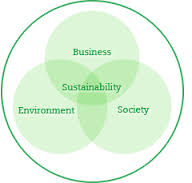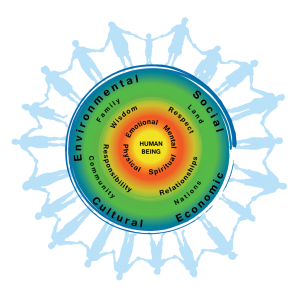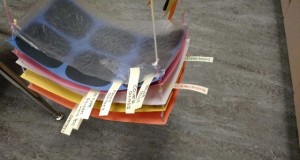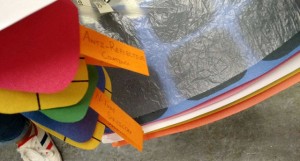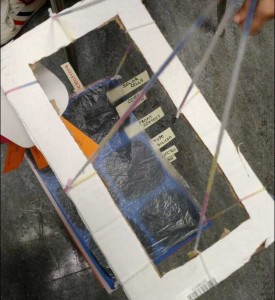Category: Science 9
First People’s Principles of Learning
Sustainability:
Sustainability means to be able to be balanced with the environment and to take care of nature the way we would ourselves so that the world can continue to function the way it does today. It is very important to have this quality because we need to look after the environment. I think that too many people disregard the environment and always put their own thoughts before the environment’s well being. Sustainability is an important teaching and should be thought about more often.
In class this year, we learned about how much energy we use and how we could reduce our energy usage. We also learned about renewable energy and non-renewable energy sources. Non-renewable energy sources weren’t the best for our environment but people still continue to use them with no regards to our planet. We need more sustainability so that we can continue to live on our planet peacefully and so that we work harder on making use of our renewable energy so our planet can breathe.
Interconnectedness:
Interconnectedness with first peoples principles means to have everyone know that everything is connected by their roots and that by doing one thing differently than how you would normally do it, will affect everything that comes after. People can have interconnected relationships as well, meaning that they are very connected and if things aren’t how they normally are, something could change in their relationship. For example, if one person acts differently to the other, or in a rude manner, it will cause problems with the relationship because they are so connected. If they didn’t have an interconnected relationship, then it wouldn’t change much if one person acts differently, because they didn’t have any connecting roots in the first place.
Something that we had learned this year about the environment that has a link with interconnectedness would food chains and cycles. If one animal in the food chain disappears, the whole chain will falter and the animal species in the chain will not be very stable. It’s almost the same with cycles. For example, in the water cycle, if the ice from the mountains would not melt and fall onto the ground, there would be no water to evaporate or steam, so there would be no condensation, meaning there would be no rain, and the whole cycle would fall apart. If the cycle fell apart, so would our water source and things would not go very smoothly.
Technology and Genetics Project on GMO
What is the problem your topic is trying to solve?
The problem that our topic, GMO, is trying to solve is to create superior genes in food so that crops would be able to withstand different difficulties. For example, when corn is planted, many insects flock to the crops, so the farmers will spray the corn with pesticides to keep the bugs off. The problem with pesticide is that it ruins the corn’s quality, so by genetically modifying food we are able to make farming much easier.
What assumptions are made by your sources?
IRT (Institute for Responsible Technology) makes an assumption saying that “evidence suggests that genetically modified foods, such as soy and corn, may help explain the recent explosion of gluten-related disorders, which now affect up to 18 million Americans,” however, The Genetic Literacy Project and CDF (Celiac Disease Foundation) claims that the statement is false. First of all, the claim that IRT made has no scientific proof to make sure that the statement is true. Second, when Jeffrey Smith, who runs IRT, posted that claim onto his blog in 2013, genetically modified wheat was not commercialized yet. To add on, University of Georgia’s Dr. Wayne Parrott claims that over 1000 studies have found no evidence that GMO causes health effects.
(Genetic Literacy Project, 2015), (Isaaa, 2013), (Celiac, 2013)
What are the writer’s biases?
Between the three websites that I used, I found that one website (The Lugar Center) was for GMO. They’re thoughts on the subject were positive and focused on the good side of GMO, however, the next website I looked into (IRT) was completely against genetically modifying. They listed many reasons on why we should not be buying GM products.
What social implications does your topic have?
There are many social implications of GMO, some good and some bad. In a more positive aspect of GMO, we could easily conclude that genetically modifying would definitely increase food, but not nearly enough to end world hunger, as some of the sites stated. The crops are easier to grow therefore more food would be produced, but we aren’t always sure if this food is safe. Many people doubt genetically modified foods and believe that it leads to illness and disease. The excess amounts of pesticides and chemicals that protect the crops against insects are harmful to humans, although the crops are washed thoroughly and are disposed of the harsh chemicals, many still proclaim that it causes damage. In stores, non GMO products are being put on the shelf and are way more common to see now then when GMO was first introduced. Non GMO products are more expensive than the usual GM foods, making people who want to keep this non GMO lifestyle have to dig deeper in their pockets.
What ethical implications does your topic have?
The ethical implications of GMOs is that most people think it is “wrong” to use GMOs. This would be because most people believe that GMOs only have a negative impact, however, there are multiple benefits of GMOs. For example, genetically modified corn can be insect resistant. It benefits people by increasing the amount of food that is made and makes that food more resistant to negative things such as pesticides. Overall, it mostly has a positive implication on our world today.
Evaluate your topic and whether it is a satisfactory solution to the problem, given the weaknesses you have already addressed.
There is no “satisfactory solution” to the problem with GMOs. Many people, scientists and non-scientists, believe that GMOs can cause or increase the change of diseases, such as cancer. However, that is not true, or at least most research papers state that it is not true. This is a large debate that continues every day. The weakness of this topic is that a large number of the general public is biased towards the fact that GMOs do lead to a list of diseases which makes it difficult to come up with a final solution, whether it be a decreased use of GMOs or that it is used in a different way or to not be used at all.
What is your personal stance on this topic?
For me personally, I don’t agree with genetically modifying foods. After doing my research, I didn’t see anything too remarkable. GMO doesn’t seem like it’s helping society by much, and I saw more negative aspects than positive. Instead of hearing about what genetically modifying has helped us achieve, I mostly saw stories about people who had been affected badly by it. The whole idea of ending world hunger by genetically modifying food is far too big of a dream when GMO really hasn’t proven much in the first place. Sure, genetically modifying helps farmers grow crops, but does it benefit humans as well? The only thing GMOs have increased is the use of pesticides and other chemicals which are harmful to humans and to the planet. I say that non GMOs would be a better choice than GMOs, but that’s just my opinion.
Bibliography:
(The Lugar Center, n.d.)
(Jeffrey, 2011)
(ISAAA, 2013)
(Katiraee, 2015)
(Hennessy, 2013)
(Open Letter from World Scientists to All Governments Concerning Genetically Modified Organisms (GMOs), 2000)
(Tribe, 2013)
Meiosis Analogy
by: Rose, Belinda and Sam
Mitosis Worksheets
Asexual Reproduction Lesson 1
How Things Work
- Form and Function: Solar cells, which make up solar panels, use the sun to create electricity. But how do solar cells, or solar panels, do that? Solar cells produce electricity by using the photoelectric effect. The photoelectric effect is light being used to push electrons, which frees them from the surface of a solid, except, there must be enough light to push the electrons. Inside a solar cell, there are two thin layers of silicon crystal- they are placed on top each other like a sandwich. Both top and bottom layers have been treated to have unstable atoms, the top wants to get rid of an electron and the bottom wants to gain an electron. This creates a reaction that encourages the electrons to move in the silicon crystal when the solar panel is exposed to light to make electricity; however, before that electricity can be used, it must go through an inverter to convert the direct current electricity that the solar cells create to alternating current that a house uses.
- Social Implications: The social implications of solar cells will vary depending on the area. For example, in a colder region where there is a lot of rain and little sun, a solar panel may be useless, whereas in a warmer area, the solar panel would get a lot of sun and be a great energy source. Another implication could be the price. Solar cells are usually sold in panels or in a solar array and for some people to want them them installed on their house, it would be a lot of money being spent all of a sudden, typically being around $19,500. Since the price is pretty high, developing countries might not be able to afford it, so it may not be beneficial to all countries. Although the prices for a solar array to be installed on homes have been dramatically decreasing, they are still quite pricy but once they are installed, energy and be produced by whomever owns them for free. Also, these solar panels are not all “invincible”, many parts of the panels need to be replaced. For example, an inverter would require to be replaced in about 10 to 15 years; however, many companies offer a roughly 25 year warranty for homeowners who would like to buy and install an array installed on their home. There is even the chance of being paid back by companies, if the solar system on their house produces extra energy, they can get money by selling the extra energy.
- Ethical Implications: The higher demand of solar panels have lead to a decrease in solar panel prices. This is good for the earth as we are making more environmental friendly energy, but for the people working in factories that produce energy, it may not be. There would be a decline in people working in factories that use non-reusable energy if solar power increased and because a primary source for energy. Solar panels are very useful and can create a lot of energy, especially during peak sun hours, especially if they are installed facing the right way. According to the Pecan Street Research Institute, houses with solar panels facing the west produced up to 49% more energy than panels facing toward the south. A rise in solar power being used also affects our surroundings and us. With less pollution, the air becomes better quality and the risk of respiratory issues from pollution becomes lower.
- Environmental Implications: By using solar cells, it will help the environment by a lot. Solar cells run solely on the sun’s energy and do not need gas or other polluting resources, which lessens pollution and helps the environment. Especially over time, if more buildings continue to add solar panels, there could be a drop in fuel prices and air pollution. In addition to the drop in fuel prices and pollution, it could also affect public health and the food that people eat. The global warming being caused today is raising food prices and encouraging water shortages, with solar panels being installed, this would no longer be such a big problem as the world starts to cool down.
Examine: I think that this project went well. We had a way to contact each other if they were ever any problems, but fortunately we didn’t encounter any except for in the beginning when deciding on a model. When deciding a model to create, we had different ideas, but in the end we settled on something that we were both fine with. In conclusion, this was a pleasant project and I think that we cooperated well.
Partner : Belinda
Household Electricity Collage
Science App Review
My problem was wanting to learn more about science in step by step methods so that it would be easier to understand.
My intentions were to find an app that taught lessons that could be looked at when you’re short on time. I wanted the lessons to come separately instead of having one big lesson on a certain area so that you could exit the app after looking at the lesson you needed.
To resolve my problem, I found an app available in the app store named Khan Academy. The app is very useful for on the go learning because its lessons are short but impactful, and not only does it teach science but a lot of other subjects as well. I looked through a couple of other science apps also, but this one was the one that stuck with me the most because it taught the lesson in a way that made it easy to remember for me personally. 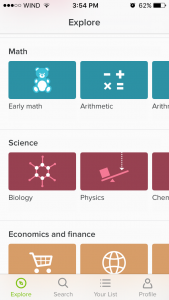
This app could help our science class greatly because with almost every lesson comes a video so that if you don’t understand the written parts of the lesson, it will also be explained in a video. The app does require Wi-Fi, but you can pre download lessons so that you won’t need Wi-Fi. It’s also quite fun because along the way, you earn badges and accomplishments. The app also tracks your progress so that you can see how well you’re doing so far. When you get onto the app, it immediately takes you to its ‘learn’ page, which consists of a few different subjects to learn about. In honesty, the app could cover more subjects, but it had enough for the science 9 course. I clicked on science and went onto the chemistry unit since I already had a basic knowledge of chemistry and wanted to know if it taught everything correctly and if it taught me more than I already knew. 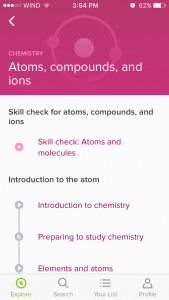
The lesson starts with going over your basic knowledge to see how much you know about the subject. There are four questions you have to answer, but if you don’t know the answer, don’t worry! The app gives you hints and will show you a video about the question so that you’ll understand better.
Once you finish the mini quiz, you go onto the first lesson which consists of a video to give you a quick introduction into the course.
If you finish the entire course and still have questions, you can go onto the ‘search’ page and search up whatever you don’t understand or need help with. Then, a whole bunch of videos and lessons will pop up to help you. 
Personally, I thought that this app was great for learning no matter what level of understanding you have of the subject.
QUESTIONS:
- The app helps users build skills by providing one lesson after another so that the learner is always learning more whenever they use the app. If the learner learns best with reading and watching videos, then this app will be very helpful.
- Kahn Academy is a pretty self-explanatory app and can be used by anyone. It doesn’t take long to figure out how to use it because everything is laid out in front of you the second you open the app.
- I’d say that the app is pretty innovative because not only does it offer to track your progress but it uses badges and accomplishments to motivate the user. It also lets the learner search for whatever they’re having troubles with and results show up in a matter of seconds. So yes, I think this app is quite innovative.
In conclusion, this app was very helpful to me because of all the video lessons it provided, but if watching video’s doesn’t help you, I recommend not trying this app because majority of the lessons are done through video. I think this app could be useful in the classroom if the teacher uses the videos as examples to go with his/her lesson instead of only putting on the video for us.
